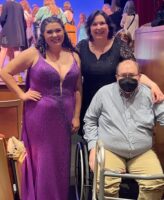Three-time stroke survivor from Middlebury, VT and his wife share their journey
October 29 is World Stroke Day. The American Stroke Association, a division of the American Heart Association, a global force for healthier lives for all – is dedicated to saving people from stroke. Stroke is the No. 2 cause of death in the world and a leading cause of serious disability.
Strokes can happen to anyone at any age. In fact, globally one in four adults over the age of 25 will have a stroke in their lifetime. Each year, approximately 800,000 people in the U.S. suffer a stroke. Most adults in the U.S. do not know the F.A.S.T warning signs of a stroke, and that stroke is largely treatable if you call 911 as soon as you recognize the symptoms.

Trent Campbell
Trent Campbell of Middlebury, VT survived three strokes over the past five years. In October of 2018, Campbell was working as a photographer for the Addison Independent, a local newspaper. While walking back to his car after photographing a college sporting event, he couldn’t walk straight and was veering in one direction. Later that day, he vomited but then felt better. During the night he woke up to use the bathroom and still noticed he was struggling to get his balance.
The next morning, he went to the ER where they found evidence through a CT scan of a prior stroke. His wife of seven years, Nikki Juvan, recalls that he had been sick earlier that year, however, they had no idea he suffered a stroke. An MRI confirmed that he had had a cerebellar stroke, which happens when blood supply to the cerebellum is stopped. This part of the brain helps with body movement, eye movement, and balance.
By the following March, Campbell had made progress with physical and occupational therapy and had traded in his walker for a cane. While reaching for his cane to stand up, he fell right back down on the bed. After an overnight stay at the hospital, another stroke was confirmed, this time the location of the stroke was in his brain stem.
Over the next month, he developed aspiration pneumonia as a result of his last stroke which paralyzed one of his vocal chords causing him to have difficulty swallowing. He needed to be on a feeding tube during a two-month hospital stay. He also realized he suffered from atrial fibrillation (AFib) after his second stroke, putting him at a five times higher risk of stroke. Most strokes caused by AFib could have been prevented with effective treatment, but only about half of AFib patients receive proper therapy.
Over the last several years since that stroke, Campbell has continued therapy but also deals with severe peripheral neuropathy which has made progress challenging. He started attending Project Independence, an adult day center, and has become an integral part of that community. Campbell said he wishes he had known “how hard it was going to be to do the work of recovery at home.” Unfortunately, in March of 2022, he had another – yet smaller – stroke.
Recognizing the stroke warning signs and calling 911 immediately may make the difference between a strong recovery or long-term disability, survival or death. New this year, by uploading a selfie and recording your voice, you can see and hear what some common stroke warning signs may look and sound like on you with the Association’s new F.A.S.T. experience. Visit www.Stroke.org/Fast-Experience to use this new interactive tool to help you recognize stroke warning signs in yourself and others.
Learn how to spot a stroke F.A.S.T.:
- Face Dropping – Does one side off the face droop or is it numb? Ask the person to smile. Is the person’s smile uneven?
- Arm Weakness – Is one arm weak or numb? Ask the person to raise both arms. Does one arm drift downward?
- Speech Difficulty – Is speech slurred? Is the person unable to speak or hard to understand? Ask the person to repeat a simple sentence, like “The sky is blue.”
- Time to call 9-1-1 – If someone shows any of these symptoms, even if the symptoms go away, call 9-1-1 and get to a hospital immediately. Check the time so you’ll know when the first symptoms appeared.
Other stroke symptoms include sudden onset of the following:
- Numbness or weakness of face, arm, or leg, especially on one side of the body
- Confusion, trouble speaking or understanding speech
- Trouble seeing in one or both eyes
- Trouble walking, dizziness, loss of balance or coordination
- Severe headache with no known cause

Trent with his wife and stepdaughter
Through all of their challenges, Campbell and his wife have both learned how important it is to advocate for him and to keep track of nurses, therapists, and doctors who have helped in the past because they could be the key to getting help in the future.
Campbell’s doctors can’t guarantee he won’t have another stroke, but he and his wife Nikki believe that they can still have a meaningful life and can do anything with planning, determination, humor, and hope. They participate in a local stroke support group and share some of the difficulties of navigating life after a stroke.
“I have to stay hopeful and find the strength that we both need to have to carry us through the inevitable difficulties. I have to fight the insurance company to give him more physical therapy sessions even though I know we probably won’t get them. I have to research ways for us to travel to New York City, one of our favorite places pre-stroke, and maneuver the streets without launching him out of the wheelchair on an unexpected bump. I see the world through different eyes now,” said Nikki Juvan.
According to the Association, a large majority of strokes can be prevented through education and lifestyle changes such as moving more, eating smart and managing your blood pressure Knowing your numbers such as total cholesterol, blood pressure, blood sugar and body mass index can help reduce your risk, as well as knowing your family history of heart disease and stroke.
The Association encourages you to learn these numbers and your family history, and then talk to your doctor about lowering your personal risk for stroke. In addition to checking your blood pressure and taking medication as prescribed, quit smoking and vaping, eat better, get healthy sleep and be active—these things not only help you avoid health problems issues later, but they also set a great example for those around you.
For more information, visit www.Stroke.org/WorldStrokeDay.